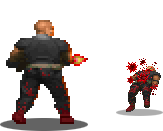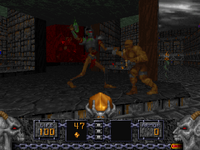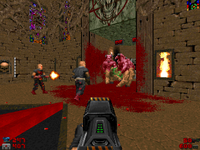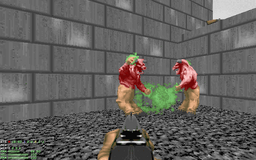Tag: Source edit |
Tag: Source edit |
||
| Line 48: | Line 48: | ||
The strategy of provoking monster infighting is complicated by a few factors. |
The strategy of provoking monster infighting is complicated by a few factors. |
||
| − | Primarily, demonic monsters of any species are immune to their own kind's projectile attack (with the exception of Lost Souls attacking other Lost Souls), unless a barrel is hit and damages another of their kind. Hell Knights and Barons of Hell are of a single species in this sense, and cannot hurt one another with their green fireballs, except indirectly by destroying a barrel. Although a given species of monster is immune to its own type of attack, they still employ it with its customary frequency while targeting one another. The immunity also means that those individuals from the same species cannot actually inflict damage no matter how many times they attack each other except by destroying additional barrels or if they get close enough to each other to use a non-projectile attack, like claws or a bite. Arch-viles are subject to peripheral blast damage from the attacks of other Arch-viles on nearby monsters, but do not retaliate because they cannot be targeted by any monster. |
+ | Primarily, demonic monsters of any species are immune to their own kind's projectile attack (with the exception of Lost Souls attacking other Lost Souls), unless a barrel is hit and damages another of their kind. Hell Knights and Barons of Hell are of a single species in this sense, and cannot hurt one another with their green fireballs, except indirectly by destroying a barrel. Although a given species of monster is immune to its own type of attack, they still employ it with its customary frequency while targeting one another. The immunity also means that those individuals from the same species cannot actually inflict damage no matter how many times they attack each other except by destroying additional barrels or if they get close enough to each other to use a non-projectile attack, like claws or a bite. Arch-viles are subject to peripheral blast damage from the attacks of other Arch-viles on nearby monsters, but do not retaliate because they cannot be targeted by any monster. This rule is less strict in [[Heretic]], where monsters of the same species but different abilities, including [[Gargoyle|Gargoyles]] vs. Fire Gargoyles, and [[Golem|Golems]] vs. Nitrogolems, can still infight and kill each other. |
All former humans (Zombiemen, Shotgun Guys and Chaingunners) can and frequently will damage and kill each other due to the hitscan nature of their attacks and the ease at which they can be made to accidentally hit each other. |
All former humans (Zombiemen, Shotgun Guys and Chaingunners) can and frequently will damage and kill each other due to the hitscan nature of their attacks and the ease at which they can be made to accidentally hit each other. |
||
Revision as of 18:45, 1 May 2021

In DOOM, a Shotgun Guy killing another of his kind.
In the Doom games, Heretic, and Hexen, many of the enemy monsters can be tricked into fighting each other, a phenomenon which is generally called monster infighting. This can usually be accomplished by getting into a position where one monster is in the line of fire of another. Since a monster does not have the intelligence to cease fire in the event that a fellow monster blocks their line of sight, it will attack in revenge without regard, possibly resulting in friendly fire. The damaged monster may then target the attacker, where combat between the two monsters will soon follow and continue until one participant either dies or is distracted by a third party's attacks. In the Doom games, monsters will also retaliate when damaged indirectly by exploding barrels.

Infighting does not just occur in Doom. Here, in Heretic, an Undead Warrior has managed to anger a Golem.
Monster infighting has become a novel aspect of Doom and its progeny. Indeed, most games do not give the enemies the ability to hurt each other, much less the ability to retaliate. Additionally, in more recent first-person shooters, enemies are either intelligent enough not to fire if a fellow enemy is in the way, or to avoid the line of fire of other enemies. Some games, however, such as Postal 2, incorporates enemy infighting into the atmosphere of the story.

Two Shotgun Guys fighting a group of Barons of Hell in Brutal Doom v20
You can trick enemies into assist you in fighting other stronger demons, while treating them as your "temporary allies". Finish them off only after defeating the stronger demon if they are not dead.
Monsters capable of causing infighting
Monsters that have inaccurate, repeating, or blast-damage attacks (Zombiemen, Shotgun Guys, Heavy Weapon Dudes, Wolfenstein SS officers, Mancubi, Arachnotrons, Spiderdemons and Cyberdemons) are particularly likely to cause infighting.
Any monster that fires projectiles (the previous plus Imps, Cacodemons, Revenants, Hell Knights, and Barons of Hell) can be maneuvered into doing this. Lost Souls, being projectiles themselves, can damage other monsters found on their attacking path, likewise causing retaliation (though unlike most projectiles, Lost Souls created by Pain Elementals will still be targeted instead of the Elemental).
Monsters unable to cause infighting
Monsters damaged by an Arch-vile's attack will never retaliate because there is an exception in the source code that prevents other monsters from targeting them. This does not stop Arch-viles themselves from targeting and damaging other monsters, though. Arch-viles are easy to distract, as, unlike other monsters, their lack of a targeting threshold means they will always switch target when hit.
Pain Elementals, whose attack is carried by proxy monsters, cannot provoke other monsters, but will still turn on attackers if provoked. The Lost Souls released during its infighting attack will be the ones causing the damage to the Pain Elemental's intended target and will be subsequently attacked by it rather than the Pain Elemental, but since Lost Souls aren't the ones who turned on the monster in the first place, they will still target and attack the player (however, the infighting target may not attack the Lost Souls spat out right away even if damaged, and the Lost Soul will only attack the Pain Elemental's target upon it attacking the Lost Soul itself). However, if a Pain Elemental is too close to its target, the Lost Souls will explode harmlessly, causing no damage at all.
Barons of Hell and Hell Knights have an immunity to each others' projectiles coded onto their mobj IDs. (This was not kept in PlayStation/Saturn Doom and Doom 64).
Hanged Commander Keens can't attack at all, so they can neither provoke other monsters nor retaliate when they are damaged by projectiles.
Also, in Heretic and Hexen, no monster will retaliate against "boss" opponents who accidentally strike them outside of the mass infighting detailed below. Code-wise, this is handled by a flag, NoTarget actor flag in decorate, attached to the boss mobjs.
Melee monsters and infighting
Monsters that are melee fighters cannot initiate monster infighting by mistake. This concerns enemies such as Doom's Demons and Spectres; Heretic's Gargoyles, Golems, and Sabreclaws; Hexen's Ettins, Centaurs, and Stalkers; and so on. The source code reveals that melee attacks are impossible to misdirect; the damage is directly inflicted on the target if it is within range. Aiming is not involved and therefore hitting another target by mistake is impossible. To get them involved in infighting, the player must maneuver himself so the melee monster is between the player and a projectile-throwing enemy and gets hit when the projectile thrower attempts to shoot the player.
However, Richard H. Hank Leukart, III's Official Doom FAQ states that misdirected melee attacks do happen and can trigger infighting. Before v1.5 of the engine, A_SargAttack (the demon attack codepointer) used a short-range hitscan attack. This also applies to the Jaguar, PlayStation,and Saturn ports. As a result these versions permit Demons and/or Spectres to be provoked into damaging each other if a group of them is approached by a partially-invisible player. From v1.5 onward, the hitscan routine is replaced by a simple distance check, making this tactic ineffective.
In some maps such as the Tenements, being on a lower level than a group of melee monsters could provoke monster infighting. Going up and down stairs can allow the attacking Demons to turn and can hit another if it gets in the way, resulting in fighting each other. This was discovered in the PlayStation port.
Tactics
Monster infighting is an important tactic in levels where ammunition is very scarce, such as those of Alien Vendetta; when recording speedruns, especially in a restrictive category such as UV Tyson; or when playing a map or mod with a large amount of enemies (like Holy Hell or Totally Nuts, or Go 2 It). Causing many monsters to destroy or seriously damage one another greatly reduces the burden on the player's resources. The easiest way to do this with a large group of mixed monsters is to run in a circle several times around the group, which will almost certainly start an infight due to stray projectiles. This is allowed by the unusually high player-versus-monsters speed ratio in Doom engine games that grants the player the ability to maneuver around groups of monsters with more ease than in other first person shooter games.
Arguably one of the most prominent examples of this strategy can occur in Doom II MAP20: Gotcha!. This level happens to feature two of the most powerful enemies in the game (a Spiderdemon and a Cyberdemon) in the same room. Each is easily capable of dispatching the player, but with quick maneuvering the player can actually cause one to accidentally hit the other, starting a lengthy and entertaining fight that inevitably results in one killing the other, but not before being severely injured, making it much easier for the player to finish the job. Similarly, in other Doom II missions such as MAP16: Suburbs and MAP18: The Courtyard, use of monster infighting is essential to surviving the huge wave of monsters that spawn (especially on high difficulty settings), although the Sony PlayStation and Xbox ports of the game are known to crash or malfunction due to the stress placed on the consoles' processing abilities. MAP10: Refueling Base is another good mission in which to utilize infighting, particularly in a barracks-like area where dozens of troopers guard a key, even on easier difficulty settings.
Another advantage is that causing infighting will not alert peacefully waiting monsters like using a weapon does. For example, it may be wise to wake up a demon-spitter as late as possible.
Although Arch-viles can only single-sidedly infight another monster, this can still be useful for the player: first, the opponent is being damaged. The only caveat is that once the enemy dead, it may instantly be resurrected to its full strength, which may be worse than before the Arch-vile attack. Second, the Arch-vile will follow the other monster instead of the player. A Cyberdemon accidentally hitting an Arch-vile often leads to the Arch-vile moving close to the Cyberdemon and into its line of fire, and likely finished off by consecutive Cyberdemon rockets targeted at the player.
It should be noted that monsters in the SNES port of Doom are incapable of infighting. This is due to the fact that the enemies within it lack the ability to turn away from the player and are always targeting him/her (this, combined with the slower and often delayed controls, and the lacking of a save feature, can make this port severely difficult). However, enemies can hurt each other with friendly fire, even ones of the same species.
Difficulties

Two Barons of Hell infighting in E1M8 of Jan Van der Veken's Dawn of the Dead.
The strategy of provoking monster infighting is complicated by a few factors.
Primarily, demonic monsters of any species are immune to their own kind's projectile attack (with the exception of Lost Souls attacking other Lost Souls), unless a barrel is hit and damages another of their kind. Hell Knights and Barons of Hell are of a single species in this sense, and cannot hurt one another with their green fireballs, except indirectly by destroying a barrel. Although a given species of monster is immune to its own type of attack, they still employ it with its customary frequency while targeting one another. The immunity also means that those individuals from the same species cannot actually inflict damage no matter how many times they attack each other except by destroying additional barrels or if they get close enough to each other to use a non-projectile attack, like claws or a bite. Arch-viles are subject to peripheral blast damage from the attacks of other Arch-viles on nearby monsters, but do not retaliate because they cannot be targeted by any monster. This rule is less strict in Heretic, where monsters of the same species but different abilities, including Gargoyles vs. Fire Gargoyles, and Golems vs. Nitrogolems, can still infight and kill each other.
All former humans (Zombiemen, Shotgun Guys and Chaingunners) can and frequently will damage and kill each other due to the hitscan nature of their attacks and the ease at which they can be made to accidentally hit each other.
Additional factors that lessen monster infighting have to do with some characteristics of the Doom engine's monster AI. Monsters resurrected by Arch-viles or spawned by the final boss immediately target the player, not their creator's target. In addition, Lost Souls damaged by other monsters forget their targets after a single counterattack (whether successful or not) and then turn back to the player, although the monster that the Lost Soul had damaged does not forget the flaming skull's offense. Certain source ports include various AI options, and allow the user to decide how monsters should behave in respect to monster infighting.
There is another AI related showstopper for monster infighting: sometimes, one of the monsters that can be tricked into infighting is located on another height level. For example, if a Hell Knight on the street is hit by an Imp behind a first-floor window. In this case, projectile attacks may only be successful from far away. Unfortunately, monsters often first walk up toward the opponent, making it impossible to ever reach the other party. Sometimes, the player can help them by moving into their way.
Player interactions
During an ongoing infight, the player can attack and damage the infighting monsters. However, the infighting monsters will typically continue with the infighting and ignore the player's attacks.
During an infight, the player can naturally be injured by missed attacks and blast damage or simply by walking into the monsters' line of fire.
Other games
Monster infighting in Doom 3
In Doom 3, the monsters observe a two-level hierarchy: An "upper" class (Hell Knights, Revenants) and a "lower" class (Imps, Z-Secs). Monsters in the upper class will attack monsters in the lower class in retaliation if for example the lower-class monster accidentally hits an upper-class monster. But, the lower-class monster cannot deliberately strike an upper-class one, so the upper-class monster continues to hit the lower-class one until the latter dies, without the latter trying to fight back. Thus, Doom 3 does not contain true infighting (at least without mods), but rather only a sort of on-the-spot "execution".
In addition, such "executions" do not happen very often, because of the significantly smaller monster numbers, due to a lack of room where the player could lure the monsters into each others line of fire, and also due to the faster speed of the monsters relative to the player than in the original Doom.
Known monster ranks
The Upper and Lower classes mentioned above have been confirmed by in-game experience to consist of the following monsters:
Upper class: Hell Knights, Revenants, Arch-viles, Cacodemons, Mancubi.
Lower class: Imps, Z-Secs, Commandos, Demons, Zombies, Maggots, Wraiths, Ticks, Trites, Cherubs.
Note: It seems strange that Commandos, who are considered quite powerful opponents, would be relegated to the Lower class. This could be due to them being formerly human.
In Doom 3: Resurrection of Evil, the Grabber, which is able to grab and hurl demons' projectiles, can be used to provoke infights by hitting one demon with the projectile of another species of demon. In this case, the hit demon apparently thinks the second one bounced his projectile off the player and will proceed to attack the second demon rather than the player.
Monster infighting in Doom (2016)[1]
The Doom reboot brings back infighting in its traditional sense, and it can now be provoked using methods from previous games. They are still more difficult to trigger than in classic Doom, since projectile-firing or -throwing enemies tend to be more deliberate with their attacks, and also because the Doom reboot is true 3-D unlike the classic game. They occur more often in the more difficult skill levels such as Nightmare, where the monsters are more aggressive and have a higher chance of hitting each other accidentally, and at the same time, because of their higher hitpoints, are less likely to stun or kill each other before an infight can actually start. As in classic Doom, monsters that have inaccurate, repeating, or blast-damage projectile attacks are particularly likely to cause infighting, which in the reboot include examples such as Possessed Soldiers and Hell Razers. At the same time, very large, bulky monsters that provide bigger targets for stray projectiles, such as Hell Knights or Mancubi, are most likely to get triggered into starting an infight. Naturally, monsters with both characteristics, particularly the Baron of Hell, are most likely to end up in infights. Powerful monsters such as Barons are also particularly likely to accidentally kill other monsters during a fight, which the player can also use under certain circumstances (as, for example, briefly standing next to another monster when a Baron starts his rush and ground-pound attack, and then rushing away, causing the Baron to miss and kill the other monster). Infighting is certainly more useful on the Nightmare difficulty as well as more likely, as the player will use much more ammunition than on the easier difficulties and it is a way to ease the strain on the player's resources, as well as to provide a brief respite from the particular enemies involved.
Infights are also scripted; at various parts throughout the game, the player will often come across enemies attacking each other. The first instance of a scripted infight occurs in the Foundry, between a Possessed Soldier and three Possessed Workers. The Kadingir Sanctum has a few infights near the end, including when the Baron of Hell is first encountered.
In the SnapMap mode, players can assign demons to different teams to change their allegiances. Demons under different teams would fight each other and players under the same team as the demons would be friendly to each other.
Monster infighting in Doom Eternal
In Doom Eternal , monsters can be found infighting throughout the game with similar mechanics from the previous entry. However, unlike previous entries, monsters cannot kill each other through infighting.
Mass infighting in Heretic and Hexen
Raven Software added a feature to Heretic and Hexen which causes all monsters within sight of the player to begin attacking randomly chosen targets when the player dies in a single-player game. Monsters will fight with any living thing within their sight when this happens, including members of their own species and normally ignored creatures such as bosses (i.e anything shootable, including Voodoo dolls, in which case the player's screen will, despite being dead, still flash red each time the doll is struck). However, monsters remain unable to hurt other monsters of their own type with their projectiles even in this case, as can be viewed in p_map.c line 331, where there is no check as to whether or not the player is dead or alive when rejecting same-species projectile hits.
Besides this phenomenon, infighting occurs in Heretic and Hexen exactly as it does in Doom, as the games use the Doom engine.
Quake and Quake II
Monster infighting occurs in Quake and Quake II just as it does in Doom, despite using a more advanced engine. It happens less often, and is more difficult to provoke, than in the Classic Doom-engine games, but more often than in Doom 3. Quake involves extradimensional monsters similar to those in Doom, making the rationale the same. Quake II, by contrast, involves an intelligent alien race called the Strogg, but apparently, the Strogg troops have very foul tempers.

